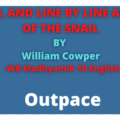THE POEM
When the warm sun, that brings Seed-time and harvest, has returned again, 'T is sweet to visit the still wood, where springs The first flower of the plain. I love the season well When forest glades are teeming with bright forms, Nor dark and many-folded clouds foretell The coming-in of storms. From the earth's loosened mould The sapling draws its sustenance, and thrives; Though stricken to the heart with winter's cold, The drooping tree revives. The softly-warbled song Comes through the pleasant woods, and coloured wings Glance quick in the bright sun, that moves along The forest openings. When the bright sunset fills The silver woods with light, the green slope throws Its shadows in the hollows of the hills, And wide the upland glows. And when the eve is gone, In the blue lake the sky, o'er-reaching far, Is hollowed out, and the moon dips her horn, And twinkles many a star. Inverted in the tide Stand the gray rocks, and trembling shadows throw, And the fair trees look over, side by side, And see themselves below. Sweet April! -- many a thought Is wedded unto thee, as hearts are wed; Nor shall they fail, till, to its autumn brought, Life's golden fruit is shed.
Word meanings related to the Poem :–
1. harvest – he process or period of gathering in crops.
2. teeming– fruitful
3. foretell– predict something
4. mould– hollow container used to give shape to molten or hot liquid material when it cools and hardens.
5. thrives– flourish
6. soft-warbled– singing in a soft trilling sound
7. glades– shining
8. trembling– shaking or quivering
9. wedded– get married
10. sapling– a young tree
About the Poet:–

Henry Wadsworth Longfellow was an American poet, as well as an Educator. He was born on 27th February 1807 and took his last breath on March 24, 1882. He was the first American poet who had translated the Dante Alighieri’s Devine Comedy. He was also known as one of the Fireside Poets from New England.
His passion was as a Poet Professor. He was born in Portland, Maine, a part of Massachusetts, at that time. His father was a lawyer. He went to Bowdoin College and later became the professor of the same college. His first amazing poetries were— “Voice of the Night” in 1839, and “Ballads and other Poems” in 1841.
After retiring from his teaching profession in 1854, he focussed on his writings. Mary Potter was his first wife who died in 1835. Later, he married to Fannces Appleton.
Longfellow wrote various lyrical poems, which were known for their musicality and were often presented stories of mythology and that of the legends.
Over long years, Longfellow’s personality and writings had become a great part of his reputation. Through publishing poetry and prose to various newspapers, he achieved his literary goals. and magazines. Some of his famous poems are- ‘ The Song of Hiawatha ’, ‘ Evangeline ’, ‘ Paul Revere’s Ride ’, ‘ Psalm of Life ’, ‘ The Children’s Hour ’, etc. He had his success, overseas.
Title of the Poem:–
The poet ends by a type of romantically asserting long-lasting environment of his love for this time of the year. This poem consists of eight stanzas. So, we must be alert that, it is being titled as, “ An April Day ”, thus it is basically describing all the beauty, and the adorable things that could be seen during one day, in April. The whole poem here, deals with that single day in the month of April, where according to the poet, the whole beauty, of the world reaches. According to him, nothing could replace such an adorable ‘beauty’ , of our Nature. Through his poems, he wants to reveal this secret enchantment to others. Thus, the title of the poem, is appropriate.
About the Poem:–
The poem, “An April Day” is a verse of celebration throughout the whole poem where the poet, Henry Wadsworth Longfellow notices the enjoyment and thus welcomes the season, whole-heartedly.
This poem was taken from the United States Literary Gazette, Volume II, in 1825, Miscellany.
Here, in this poem, Longfellow highlights on a beautiful day in April. Longfellow in his poem celebrated the Spring season and feel the essence of its beauty.
“An April Day” starts with the description of the warm sun, which returns to bring life into the trees and its flowers. The poet’s love for the spring season is cherished in the poem. Longfellow described in the poem, about how birds fly through the forests, happily, and expands on the point of how the sun’s rays come through the woods to bring it to the greenery. In the end, the poet, Longfellow, describes the scenario of a calm and peaceful night in the month of April. He wonders the beautiful night sky and explains that even the lake waters reflect the moon’s light to the forest trees. Specifically, Longfellow enjoys celebrating the spring season, by expressing the beauty of nature and that of, how this beautiful nature and its environment regains after a rough and tough winter.
Background of the Poem:–
This is one of those famous poems by H. W. Longfellow, which were written during his college life. In this poem, Henry Wadsworth Longfellow has beautifully portrayed which has its every minute details which can only be separated after a huge mentality of observation. This poem overall has a great joyous tone in it.
The poem begins with the arrival of one of the most beautiful and enchanting season, Spring. Here, the sun rises up and warms the nature to give a pleasant feeling among the woods. Also, the poet went out in the forest to feel the nature
It is said that this poem was taken from the United States Literary Gazette, Volume II, in 1825, Miscellany.
“An April Day” by Henry Wadsworth Longfellow is a great delightful reading poem for all the lovers of nature, which talks to a joyous ride of the forests which is being filled with flowers and honey bees.
ALSO, READ
- Perform Online Pokies Regarding Real Money Lucky Cash Codes No Max Cashout No Down Payment Bonuses
- Uptown Pokies Mobile Online Casino Regarding Australian Participants
- Find Out Uptown Pokies On Line Casino And Carrier Your Self A Massive $8,888 Plus Three Hundred And Fifty Spins To Take Enjoyment In Top-tier Online Pokies Gaming!
- Discover Typically The Amazing Provides At 500 Online Casino Catch The Chance Now!
Line by line analysis of the Poem:–
Stanza 1:–
When the warm sun, that brings Seed-time and harvest, has returned again, 'T is sweet to visit the still wood, where springs The first flower of the plain.
The time when the poem is written by the poet, was Spring time, and the morning bright sun id coming up.
Here, the 1st stanza helps us to introduce to the beautiful season, namely, Spring; where the poet tells us that the sun has returned. As we all know that, according to the process of photosynthesis, the rays of the sun plays a major role in the growth of the plants and its flowers. And that is all about the poet is talking here, where he tells that the sun, “brings/seed-time and harvest”. The seeds underground, need the rays of the sun to rise up to be big trees and that of similarly, the fruits too need sun rays to ripen. Thus, the very establishment comes back after a year.
In this season, the sun appears on the earth, after a long break from the last season. And now, our poet is very excited about visiting the forests because this is that time of the year when the new and pleasant flowers come up and a variety of greenery is seen germinating all over the plains. This, according to the poet, it is one of the best scenery, that should be kept carefully and that should not be missed.
Stanza 2:–
I love the season well When forest glades are teeming with bright forms, Nor dark and many-folded clouds foretell The coming-in of storms.
Here, in the forest, these are all kinds of bright things to look, and also the season is not stormy.
In this 2nd stanza of the poem, the poet gives us a strong reason as to why he is in love with this season, to that extent.
He says that it is that time of the year when the marshy forest lands get covered with the colourful and bright flowers and plants. This new generation of flowers and plants, with a complete new life and with that of a new atmosphere of the woods, is chirpy and gay.
We have seen that, in other seasons, the country is covered with storms and sudden rain, which cannot be mentally appreciated by the people, all around. But during this season, of the year, there are no dark clouds in the sky; the sky seems happy, and no natural indications of upcoming storms can be found in the clear and blue sky. Thus, the poet wants to tell that, the month, April, is full of freshness and freedom, where there is, everything bright, beautiful and mesmerising.
Stanza 3:–
From the earth's loosened mould The sapling draws its sustenance, and thrives; Though stricken to the heart with winter's cold, The drooping tree revives.
In this season, Spring, the saplings are growing up and the older trees are starting time perk up.
The 3rd stanza is the explanation of the growth and development of the new baby trees. The poet, H. W. Longfellow, highlights the natural and enchanting process of reproduction and germination of seeds. The seeds, which got cold, during the harsh winters, but was still surviving in that uncomfortable conditions, extracting its needs for sustenance from the soil where it was been harvested. And it is this season, Spring when the almost fragile trees regain its strength and come to its normal life.
Stanza 4:–
The softly-warbled song Comes through the pleasant woods, and coloured wings Glance quick in the bright sun, that moves along The forest openings.
Here, the poet, H. W. Longfellow, listens carefully the singing of the birds and sees minutely, the colourful wings of the birds.
In the 4th stanza, the poet describes the other gifts by the Spring, to us. And it is the enchanting music, of the birds, which we can only hear at the time of Spring season.
During this time of the year, the birds rejoice themselves and they become extremely happy which make them in the mood to sing and dance, and spread happiness. It is the enthusiasm of nature, that fills the woods with a complete sense of colours and also music. Here, in this season, the beautiful birds fly under the sun and jeep spreading the natural colours and the natural sounds to the people, all over.
Stanza 5:–
When the bright sunset fills The silver woods with light, the green slope throws Its shadows in the hollows of the hills, And wide the upland glows.
Here, the poet describes about, how the sun starts setting at the day ends and make the whole forest and its surrounding hills and mountains, look enchanting.
The 5th stanza, is a continuation of the praising of nature, by our poet, H. W. Longfellow. He has been enchanted by the beauty of nature. This stanza represents itself as the most charming and enchanted of all, in the poem. It helps us to imagine in a different level about nature and about its beauty.
Stanza 6:–
And when the eve is gone, In the blue lake the sky, o'er-reaching far, Is hollowed out, and the moon dips her horn, And twinkles many a star.
Here, the speaker describes how the evening comes slowly and he is enjoying the beauty of the woods, lakes, sky, moon, stars and all above.
In this 6th stanza, the poet reaches at the end of the whole beautiful April day. These lines represent the evening beauty and its glory. Here, the lines are full of imagery, where the poet is exposing about the reflection of the night sky over the water, below. The poet describes in such a way that, a lake is appearing as the sky along with the moon in it. Here, the poet creates a beautiful and imaginary portrait of the stars and the beautiful moon on the lake, shining with grandiosity.
Stanza 7:–
Inverted in the tide Stand the gray rocks, and trembling shadows throw, And the fair trees look over, side by side, And see themselves below.
Here, in this part, if the poem, the lake is being reflected beautifully, in the whole scene through the poet’s eyes.
The 7th stanza can be expressed as the continuation of the 6th stanza, of the poem.
Here also, the poet praises the reflections caused in the water at night.
According to him, the moon and the vegetation along with the hills are similar, which casts a shadow in the water, which seems as inverted. When the lake water creates waves in it, it also gives a different effect on the reflection of the trees and the trembling ricks. The poet thinks that the trees might be looking at their own shadows in the water and would feel fascinating.
Stanza 8:–
Sweet April! -- many a thought Is wedded unto thee, as hearts are wed; Nor shall they fail, till, to its autumn brought, Life's golden fruit is shed.
The beauty of this season has so fascinated the poet, that now, he feels that he is in love with the month, April, for the rest of his life.
In this 8th stanza, the poet says farewell to the season, a Spring, with a whole-hearted promise that he will wait for it to come back again on the next year. The poet got a lot of attachment with this season of the year, like that of the two lovers are bring bonded. He quotes, “ life’s golden fruit is shed” when they all reach their autumn.
Structure of the Poem:–
This poem has been composed of eight stanzas with abab rhyming scheme. This poem obtains to natural beauty. It consists of full of imagery and romanticism all through the poem.
This poem runs through a specific rhyming scheme i.e., abab, which gives a beautiful notion of hearing and reading. This poem does not contain many archaic languages, thus, it is easily acceptable by common people or the readers. This poem encourages a happy tone, throughout.
Literary devices in the Poem:–
There are majorly two poetic devices used in the poem. The use of alliteration and climax add a lucidity and rhythm to the poem. They are as follows:-
- Alliteration:– here are some examples of alliteration in this poem:
- ’T is sweet to visit the still wood, where springs’
- ‘…in the hollows of the hills’;
- softly-warbled song…’
- Personification:– few examples of personification are as follows:
- ‘sapling draws its sustenance, and thrives;’
- ‘the moon dips her horn;’
- And the fair trees look over, side by side,
- Sweet April!…
- Metaphor:– the examples of metaphor in this poem are given below:
- ‘forest glades are teeming with bright forms,’
- Is wedded unto thee, as hearts are wed;
- Imagery:– there are different types of Imageries present in this poem. They are:
- Visual Imagery— ‘warm sun’, ‘first flower’, etc.
- Auditory Imagery— ‘soft-warbled song’
- Allusion:–allusion is used in the poem when the poet says:
- ‘ Life’s golden fruit is shed. ’
- ‘‘the blue lake the sky, o’er-reaching far,
- Is hollowed out, and the moon dips her horn,’
The ThemeS of the Poem:–
The beauty of Nature:–
Here, in this poem, ‘An April Day’, written by H. W. Longfellow, the extraordinary beauty of Nature has been portrayed. The beauty of the season, Spring, has decorated the woods and the mountains, thereby. The time, when our poet had started writing this poem, was Springtime, and the morning, the bright sun was gazing. The poem tells us about this beautiful nature where the season called, Spring, plays along with the birds and the trees. The poet praises the beauty of nature and the natural procedures that take place. The poet expresses the celebration of the beauty of nature. This poem aspires the readers to have an open-minded to the inexpressible beauty with which the landscape or the woods on nature has decorated herself after a long departure of wintery winds. This poem salutes the arrival of the Spring season in a different form and expression of its own.
Romanticism
Most of the poems of H. W. Longfellow has many romantic attitudes. Longfellow expressed his love doe the beautiful nature by his poems. The poet expresses his love for the beauty of the country also, like most other American romantics. The poem has a different scene of nostalgia in it. This poem also does not have a lot of archaic languages which had made it more popular and easily reached to others. In this poem, Longfellow celebrates the joy of the arrival of Spring. The poet tries to go to every detail of natural aspects. This poem is in a happy tone. The poet describes in line 5 as– “I love the season well”.
A New Beginning:–
This is one of the most important themes of the poem. Here, the port describes the seasonal changes and how people love to welcome it. Here, in the poem, the poet expresses his joy towards the arrival of the season, Spring. He tries to go to the different details of nature. According to the poem, the main meaning of it is falling into a new start or a new beginning. This reflects an idea of out with the old in contrasting to the new one. The poet is the keen observer of nature who takes notice to the changing of the seasons, minutely. Through this poem, people can make a real-life connection, just by having the same emotion about the month in April and Springtime. At this season, harvesting was also enjoyed. And this, everyone, enjoys the season changes into Spring and the minute details of the month, April.





